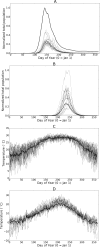The impacts of climate change on the abundance and distribution of the Spotted Wing Drosophila (Drosophila suzukii) in the United States and Canada
- PMID: 28396828
- PMCID: PMC5385127
- DOI: 10.7717/peerj.3192
The impacts of climate change on the abundance and distribution of the Spotted Wing Drosophila (Drosophila suzukii) in the United States and Canada
Abstract
D. suzukii is a relatively recent and destructive pest species to the North American soft-skinned fruit industry. Understanding this species' potential to shift in abundance and range due to changing climate is an important part of an effective mitigation and management strategy. We parameterized a temperature-driven D. suzukii population dynamics model using temperature data derived from several Global Circulation Models (CMIP5) with a range of relative concentration pathway (RCP) predictions. Mean consensus between the models suggest that without adaptation to both higher prolonged temperatures and higher short-term temperature events D. suzukii population levels are likely to drop in currently higher-risk regions. The potential drop in population is evident both as time progresses and as the severity of the RCP scenario increases. Some regions, particularly in northern latitudes, may experience increased populations due to milder winter and more developmentally-ideal summer conditions, but many of these regions are not currently known for soft-skinned fruit production and so the effects of this population increase may not have a significant impact.
Keywords: CMIP5; Drosophila suzukii; Elevated temperatures; Global circulation model; Invasive species; Soft-skinned fruit industry.
Conflict of interest statement
The authors declare there are no competing interests.
Figures







References
-
- Asplen MK, Anfora G, Biondi A, Choi DS, Chu D, Daane KM, Gibert P, Gutierrez AP, Hoelmer KA, Hutchison WD, Isaacs R. Invasion biology of spotted wing Drosophila (Drosophila suzukii): a global perspective and future priorities. Journal of Pest Science. 2015;88(3):469–494. doi: 10.1007/s10340-015-0681-z. - DOI
-
- Atallah J, Teixeira L, Salazar R, Zaragoza G, Kopp A. The making of a pest: the evolution of a fruit-penetrating ovipositor in Drosophila suzukii and related species. Proceedings of the Royal Society of London B: Biological Sciences. 2014;281(1781):20132840. doi: 10.1098/rspb.2013.2840. - DOI - PMC - PubMed
-
- Bale JS, Masters GJ, Hodkinson ID, Awmack C, Bezemer TM, Brown VK, Butterfield J, Buse A, Coulson JC, Farrar J, Good JE. Herbivory in global climate change research: direct effects of rising temperature on insect herbivores. Global Change Biology. 2002;8(1):1–6. doi: 10.1046/j.1365-2486.2002.00451.x. - DOI
-
- Brekke L, Thrasher BL, Maurer EP, Pruitt T. Downscaled CMIP3 and CMIP5 climate projections: release of downscaled CMIP5 climate projections, comparison with preceding information, and summary of user needs. Vol. 1 Technical Service Center, Bureau of Reclamation, US Department of the Interior; Denver: 2013.
LinkOut - more resources
Full Text Sources
Other Literature Sources
Molecular Biology Databases

